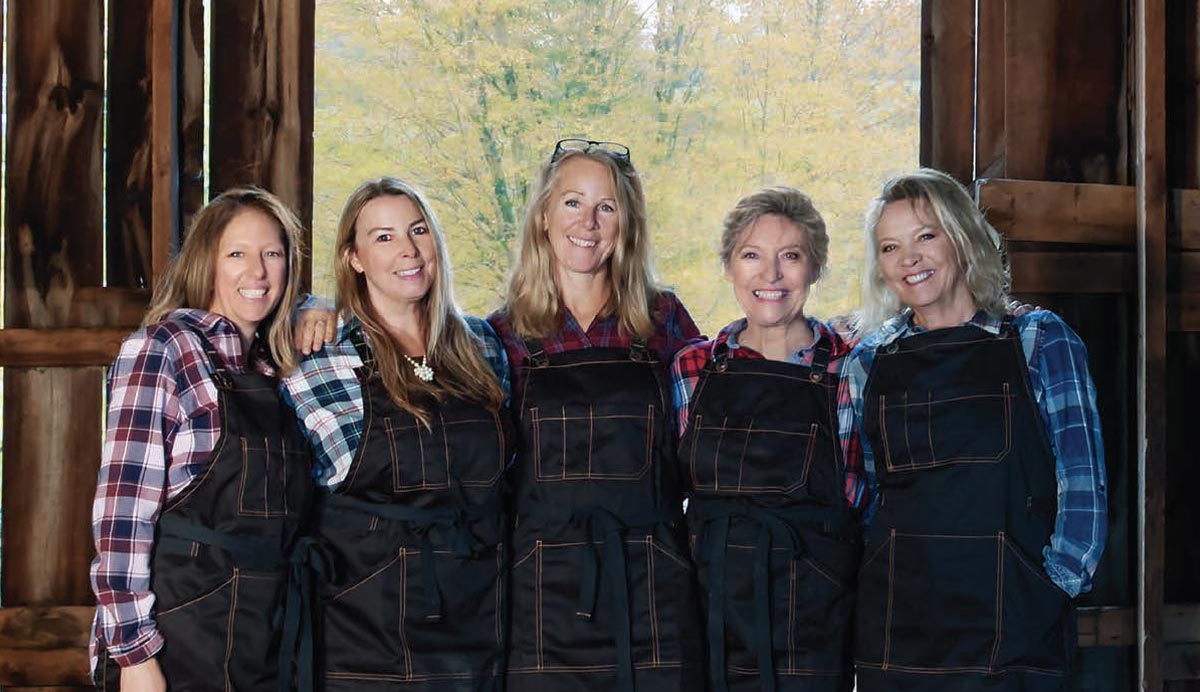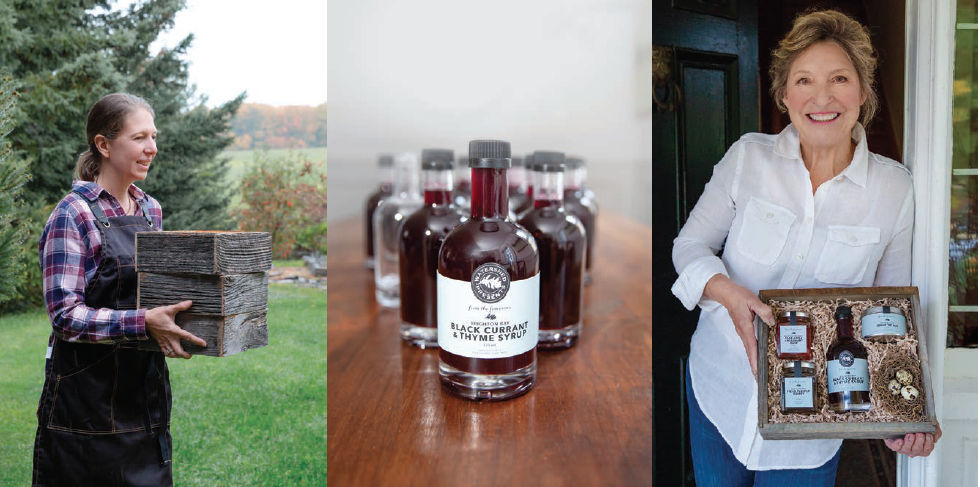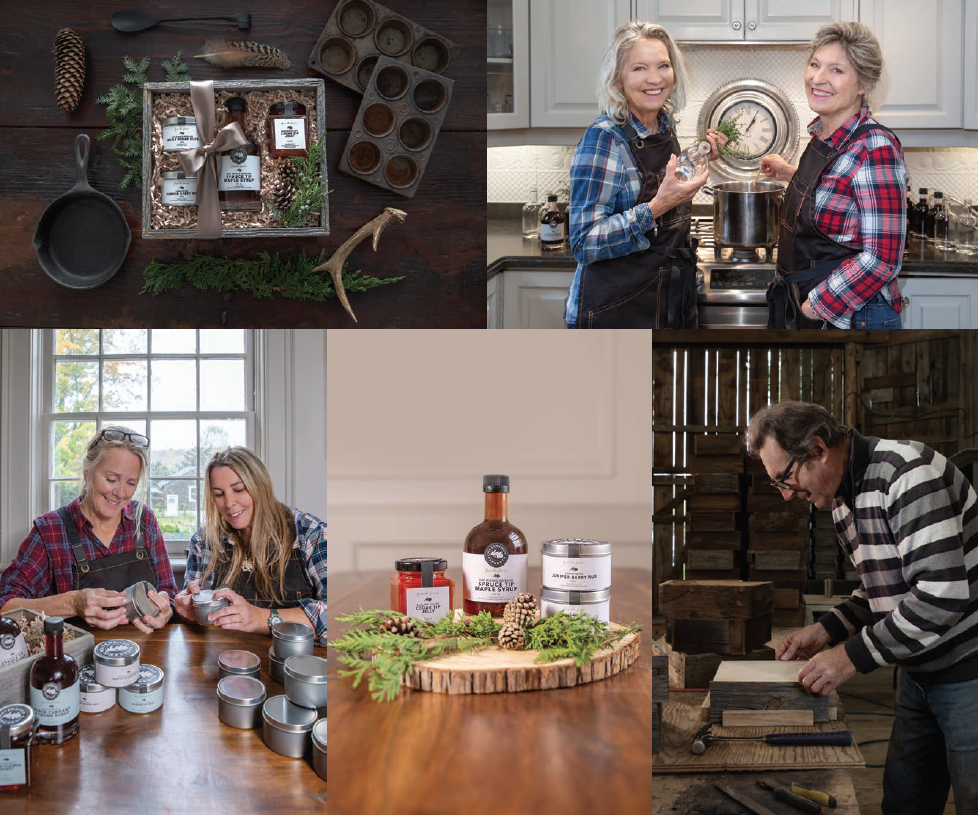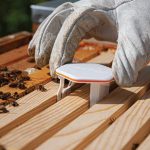
A collection of products drawn from the fields and fencerows that reflect the local landscape and our unique history
This is a story about a bunch of gals who set out on a journey together. It was an adventure that would pool our best qualities and values – creativity, determination and friendship – and test us to the limit. It was an adventure that took us down the path of history, wended its way through endless hours of developing ideas, led us into unfamiliar territory of production and made us appreciate the value of laughter.
I don’t know how the idea hatched. I’ve always been fascinated by how the settlers made their way into the wilderness, how they learned the value of the tall grass prairie and the forests from the First Nations, and how the simplest of foods could sustain them. Some of their names are familiar to people who live in the area – Catharine Parr Traill, Susanna Moodie, Susan Greeley – and other names have slipped quietly into history. Part of me wanted to uncover their stories and to explore their lives.

Another part of me wanted to celebrate my mom. She wasn’t your typical 1960s housewife looking for bridge party recipes. Her cookbooks line my bookshelves today and when I open them, I am transported back to her kitchen where the stained jelly bag hung from the cupboard door handle, drip, drip, dripping its jewel-like contents into a pot on the stove. She was forever creating jams and jellies from the fruit in her garden, but also from the wild.
Chokecherries, quince, crab apples, black currants and gooseberries bubbled and boiled on her stove over the years. I imagined adapting the recipes from my childhood to include the natural ingredients used by the settlers who foraged the edges of the forests and the fencerows for the berries that they boiled up in iron cauldrons over open fires.
But I couldn’t move forward without the help of my sister, Sheila. Suffice to say that she inherited my mother’s love of cooking and that she is my soulmate. Between us, we began to envision a line of Watershed products that would reflect the past, while at the same time tease and tempt the palate.
Cooking up ideas is one thing, bringing them to fruition is another.
In the late spring, we started foraging, carefully clipping the fragrant tips of the cedar boughs and spruce buds. We laid thousands of spruce tips on tarps to dry. We dehydrated cedar boughs in the oven and sent every moth packing, from Grafton to the very tip of Prince Edward County.
We sourced crab apples, currants, juniper berries – fruit and berries gathered from the landscape that sustained our forefathers. As the summer unfolded, our ideas began to gain steam – literally – as the pots boiled on our kitchen stoves. Samples were lined up, tested and retested lemon here, a pinch of maple sugar there – until we recognized that we were on the right track. At that point, we packed up our ingredients and headed to the Ontario Agri-Food Venture Centre (OAFVC) in Colborne to start production.

While Sheila and I managed the actual production of the Watershed Presents products, Meg and Stephanie, two gals who are both familiar to our readers, worked their magic behind the scene. Over the summer, Meg pored over fonts and pantone colours, considered every bottle and container shape until she was happy with the subtle combinations of text, colour and design elements that would showcase our products.
Although Stephanie didn’t work in the test kitchen, she was the brains behind bringing our products to market. Her understanding of social media, her organization and communications skills kept us on track, creating a pathway from production to the final delivery.
Micol joined the Watershed team a little later. Her inherent love of the landscape made her the perfect fit – just the right gal to bring the beauty of nature to our product presentation.
While the pots boiled on the stove and ideas bubbled up through the steam, Dave Manser was down in our barn, pushing truckloads of barn boards through his whining bandsaw. He handcrafted hundreds of boxes from the salvaged barnboards gathered from the countryside – weathered boxes that spoke to time and history. His dedication was an inspiration to all of us.
We had the perfect number of cooks in the kitchen to roll out two signature Watershed Presents product lines – From the Forest and From the Fencerows.
The Watershed Presents collection speaks to the landscape that we love, to our ancestors who discovered the value of the natural world and, in the long run, to a group of gals who took the seed of an idea and allowed it to grow.
Publisher’s note: They say that behind every man is a good woman. Well, when it comes to Watershed Presents, behind every good woman is a good man. Over the last six months our husbands have encouraged and supported us. When I think of what my husband John has put up with, the word saint comes to mind.
The Ontario Agri-Food Venture Centre: an invaluable resource

At first it was intimidating. A kitchen filled with vats and pipes, hoses and stainless steel tables, where utensils, bottles and jars are washed and sterilized, where ingredients are weighed and reweighed. But there we were, wearing white lab coats and hair nets ready to start production at the Ontario Agri-Food Venture Centre (OAFVC). But we weren’t alone.
The OAFVC team helped with our Watershed Presents collection of products from the outset. Our first contact was with Trissia Mellor, manager of the vast OAFVC facility located in Colborne that handles food processing, packaging, bottling, and labelling for clients throughout Ontario.
The challenge was to take our small batch recipes and convert them to the commercial scale. Trissia guided us through the process, provided us with the technical backup and the moral support we needed. There was so much we didn’t understand but Trissia was there for us at every step of the journey.
Neil Horner’s title at the OAFVC is Consulting Operations Specialist. He understands the OAFVC facility inside out. He determined what machinery best suited our production needs, he fine-tuned our production lines and provided solutions when we ran into difficulties. Both Neil and Trissia were determined that we, as newbies to the commercial food business, had the backup needed to see our products to market.
Kwame or one of the other Food Service Workers was always with us during the long hours of production. When we rolled into the OAFVC at seven in the morning, Kwame was waiting at the delivery door. In the commercial kitchen, he stirred ingredients into the massive vats, checked temperatures, sterilized bottles and watched over the bottling machine, making sure the calibration was always perfect.
The bottom line: our curated collection of products is available because of the support of the whole team at the OAFVC. Thank you.
Cooking with Wild Abandon
By Signe Langford

At play in the kitchen with what grows at the fencerows and in the forest.
I’m obsessed with food that’s collected from the wild. I get a little too excited, perhaps, stumbling upon a meadow of wildflowers abuzz with bees – I can almost taste the honey – and the sight of a tree full of apples – misshapen, neglected, but sweet – in an abandoned orchard fills my head with thoughts of jelly and pie.
Our region is bursting with a bounty just waiting to be enjoyed by the adventurous eater. And the folks behind Watershed magazine feel the same way I do about eating the tasty wild things. While I might just go outside and bring in a handful of dandelion greens to fry up, this creative team has captured the essence of the flavours that grow along the fencerows and in the forests and packaged them in pretty little bottles, tins, and jars.
I recently had the pleasure of playing with the Watershed Presents line of products in my kitchen and here are a few of the delicious ways I put them to use:
Old Kingston Road Crab Apple & Rosemary Jelly and Shelter Valley Cedar Tip Jelly – both are simply delicious – savoury and sweet on pork, poultry, charcuterie and cheeses, or straight up on buttered toast. Try a spoonful of either jelly as a topping for thumbprint cheese shortbread alongside pork chops instead of applesauce, or with the holiday bird in lieu of cranberry sauce. I fried up a buttery, crunchy, grilled cheese sandwich with local smoked gouda and the Crab Apple & Rosemary Jelly, and glazed roasted local pork side ribs with the Cedar Tip Jelly – both were out of this world. Warm up either of the jellies and use them to glaze poultry or to top a rustic fruit galette or cheesecake.
Shelter Valley Cedar Tip Rub and Johnstown Juniper Berry Rub – both of these dry rubs are super-aromatic, bursting with citrusy notes and herbaceousness. I used the cedar tip rub on a rack of pork side ribs, and on a piece of local pickerel cooked en papillote. I used the juniper berry rub with butter and fresh orange. Either of the rubs work beautifully with game, poultry, fish, and pork – juniper and venison is a match made in woodland heaven. With beef, I suggest the cedar tip rub, and of course, mix either with a few drops of oil to turn them into a wet rub; a good splash of beer, cider, wine or even yogurt will morph them into magnificent marinades.
Brighton Bay Black Currant & Thyme Syrup – this is a showstopper! The ruby colour and bold, sophisticated flavour of currants and thyme is unbelievably good over ice cream – it’s a simple yet elegant dessert. I also jazzed up a good splash of locally-distilled gin with this not-too-sweet syrup, gave it a shake with ice, garnished with a sprig of thyme or cedar, and voilà!, a new classic was born: the pretty pink Fencerowtini! Other uses: add to a vinaigrette; use to glaze meats and poultry; add to your favourite barbecue sauce recipe; use it to make unique versions of Bellinis, kirs, and other cocktails; or simply to elevate sparkling water.
Oak Ridges Moraine Spruce Tip Maple Syrup – sweet, herbal, spicy perfection. Sure, drizzle it over waffles and pancakes for that special brunch, but this very grown-up maple syrup – with its hint of herbal heat – means it complements poultry, pork, salmon, trout, and savoury waffles and fried chicken. You can add it to a vinaigrette, use it to sweeten roasted root veggies, add a drop to your favourite rye on the rocks, or pour generously over vanilla ice cream.
Oak Ridges Moraine Maple Sugar Buds – pure, simple, natural, sweetness. Think: meltingly soft rock candy. Simply enjoy like hard candy, or use a nutmeg grater or microplaner to sprinkle it over oatmeal, home baking – cookies, cakes, pastry, sweetbreads – or drop a rock of it into your coffee, tea, or hot after-dinner toddy. Grate it over a good dollop of whipped cream, you know, the one floating on top of that Irish coffee!
Story by:
Jane Kelly
Photography by:
Alana Lee




